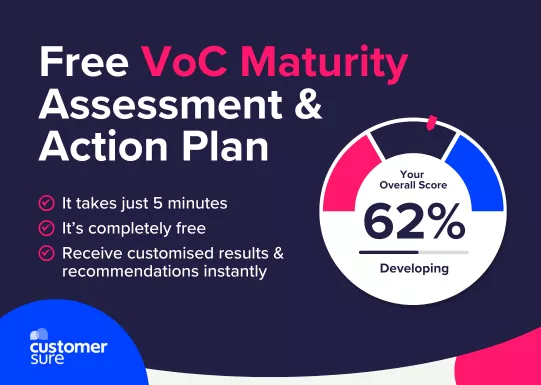

5 trends we picked up from our converations at the 2024 Institute of Customer Service Conference that we expect to shape CX for the coming year…
 Our team has just returned from the
Institute of Customer Service’s
Annual Conference.
Our team has just returned from the
Institute of Customer Service’s
Annual Conference.
It’s vital that we stay in touch with our network, to learn from both the issues they’re facing in their businesses, and the solutions they’re putting in place.
We had a brilliant day talking to current and future clients, and we’re excited to share what we’ve learned (Sharing best practice is step 5 in the collaborative model we use when working alongside our clients to improve their VOC programme!)
We’ll return to each of these topics with more in-depth, researched posts over the course of the next few months, but for now here’s a summary of the key CX trends for 2024 we saw emerging from both conversations at our stand and the day’s talks:
A lot of CX people asked us if they could trust the claims made by big tech vendors about the power of AI tools. Can AI really better inform the actions we should be taking as a result of customer feedback?
It’s interesting that over a year after OpenAI launched ChatGPT, we didn’t speak to anyone who’s seeing measurable improvements in CX from implementing GPT-based technology.
We have a big post about this coming, which we’ll share first with our newsletter subscribers, but until that’s ready, a few notes:
We’ve used ML (Machine Learning) for many years to help with things like sentiment analysis (working out how a customer is feeling based on their comments) and topic extraction (‘categorising’ what a customer is talking about).
GPTs can do these tasks well, but they come with their own pros and cons.
Don’t rush to buy something new just because it has a ‘GPT-powered’ sticker on it. You might be able to get the same results from an AI API that Google or Amazon have offered for the past decade, which have significantly more real-world testing.
Equally, there are some tasks where using centuries-old maths can outperform AI.
A great example is our Satisfaction Drivers report which tells you exactly which areas of your business are pushing up or dragging down NPS.
AI? No, we use a standard statistical tool developed in the 1880s, because it’s fast, reliable and accurate.
If you have access to good analysts, they might be able to give you more reliable answers to some questions than the inherently ‘fuzzy’ answers from GPTs.
None of this is to dismiss GPTs. Almost every member of our team uses them daily. But they aren’t a ‘silver bullet’ that will transform your VOC operations.
You can afford to wait for the marketplace to mature, and you should be very specific about the results you’re hoping for.
If you do invest, invest based on real results that you’ve seen others in your network achieve, try to avoid being an early adopter.
 Every year, more companies gather more feedback from more customers.
Every year, more companies gather more feedback from more customers.
This feedback (both quantitative and qualitative) can’t sit in isolation.
To reach the highest levels of Voice of the Customer maturity, you need to get data out into the wider business.
But equally, software integration projects take time, money, and cause grey hair.
To help balance the need to share feedback against potential IT headaches, we advise our clients:
A lot of the conversations we had at our stand were about the importance of suppliers going beyond simply providing a service, and becoming genuine partners who share best practice advice and guidance.
People in CX recognise that time spent reinventing the wheel is time not spent making customers happier, and they’re increasingly looking for partners who work as part of an extended team to add significant value by sharing best-practice advice, tips and help.
When we first wrote about this 7 years ago it was quite a radical take. Back then, customer feedback mainly lived with marketing teams, where it was processed into PowerPoint slides and shared with the board.
With the increasing professionalisation of Customer Experience as a discipline, sharing feedback is now becoming the norm. CX teams are looking for ways to make customer feedback part of business as usual, and are increasingly looking at how they can empower employees to speak to customers and ‘do the right thing’.
This is great news, and it’s something we work closely with our clients to push forward. Sharing customer feedback improves performance, can improve job satisfaction and team cohesion, and can be a great experience for customers.
Whilst the people we spoke to were keen on sharing data between systems (see trend 2), they were also increasingly keen on having a single ‘point of truth’: showing the complete CX health of a business on one dashboard.
With customer data more abundant than ever before, from Voice of the Customer surveys, to market research and focus groups, consolidating all this feedback makes it a more readily-accessible resource for the whole business.
You can consolidate in a dedicated VOC platform like CustomerSure, or in a BI platform, but teams looking for a measurable ROI on customer feedback need to ensure that their top priority is acting on feedback.
We’ll write more on each of these key trends in the coming months, but for now if you’d like to chat through the maturity of your current VOC programme, talk to us! We’d love to listen to what you’re doing and provide you with an action plan for improvement.

Gain a clear view of how mature your VoC programme is, and receive tailored recommendations to take it to the next level.
Take the assessment »Connect with a CX expert who’ll help determine your current VoC programme maturity level and provide a 3-step action plan to improve.